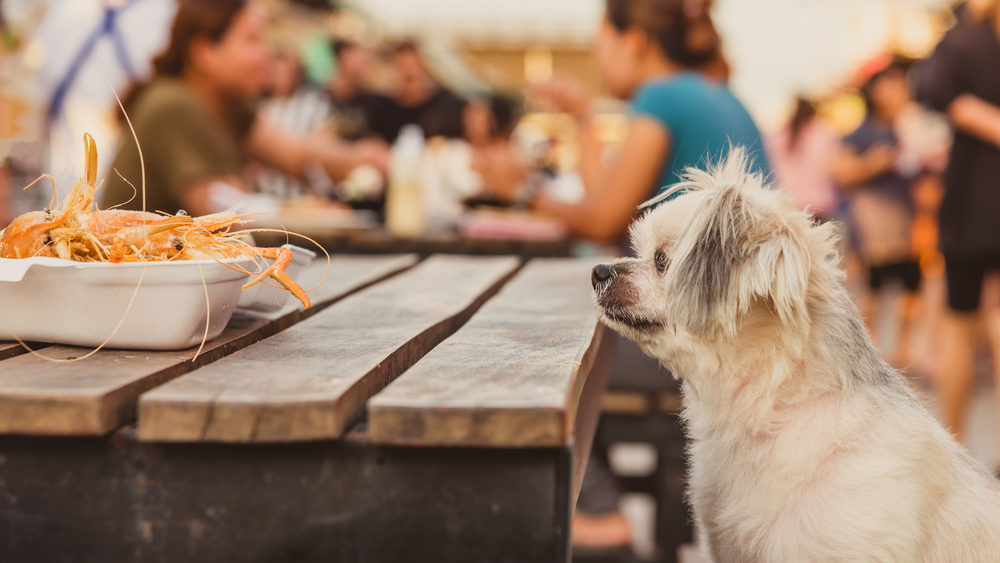Throwing a shrimp on the barbie and wondering if you can chuck one your dog’s way? Prawns are one of the tastiest and healthiest types of seafood for us humans. But are they safe for puppers? Can dogs eat prawns just like us?
They most certainly can! Prawns are actually really good for dogs, as long as you prepare them properly.
Here’s everything you need to know about prawns, dogs, and how to safely introduce the two.

Can dogs eat prawns?
Yes! There are a couple of ways dogs can eat prawns.
They can have freshly cooked prawns that you’ve prepared yourself. But only as long as you remove the head, shell, and tail, and ensure you’ve deveined them. Your doggo can enjoy cooked prawns as part of their meal, or as a healthy dog treat or snack.
Alternatively, dogs can eat meals or treats made with prawns. Many canned and dried foods use prawn as an ingredient. Some treats consist of whole dried prawns that you can feed straight to your doggo.
Are prawns nutritious for dogs?
Prawns are full of good things. Like many seafoods, they’re high in omega-3 and omega-6. These two fatty acids pack a nutritional punch and help support your dog’s skin, joints, heart, and eye health. In fact, omega-3 has been found to actually improve symptoms among dogs with osteoarthritis.
Prawns also contain protein, iron, niacin, phosphorus, zinc, selenium, magnesium, iodine, and vitamin B12. All of these are beneficial to your dog’s health. Iron, zinc, and selenium help strengthen your dog’s bones and muscles, boost their metabolism, and support the function of their nerves and immune system. Iodine can be helpful for dogs with an underactive thyroid.
One thing to note, though, is that prawns are high in sodium and cholesterol. Too much sodium can cause excessive thirst and urination, and, in extreme circumstances, sodium poisoning.
While the cholesterol in prawns is considered good cholesterol, it’s still best to feed them to your dog in moderation. This is especially important if your dog needs to stick to a low-cholesterol diet.
Now I know the answer to “Can dogs eat prawns?”, what else should I be aware of?
Prawns are largely healthy, safe treats for dogs. However, before you feed your pupper an entire school of them, there are a few things to know.
Ease into it
When it comes to prawns, start slowly to ensure your pupper doesn’t react to them. Just like humans, some dogs can have an allergic reaction to prawns. This might show up as itchy or irritated skin, or even as vomiting, diarrhea, or excessive gas.
Start by feeding your dog a small piece of cooked prawn. Then, wait to see if they have a negative reaction. If nothing surfaces, your doggo is likely fine to continue eating prawns.
If your pupper does display signs of an allergic reaction, take them straight to the vet. If you’ve taken out comprehensive dog insurance, their check-up will be covered.
Remove all the nasty bits
When feeding prawns to your pupper, properly preparing and cooking them is key. Make sure to remove the outer shell, head, tail, and vein before your doggo chows down.
First and foremost, there’s a risk that your dog may choke on a chunky piece of shell. And even if the shell makes it to your dog’s stomach, your doggo might have trouble digesting it. The shell can block or get caught in your dog’s digestive tract, which may result in nasty perforations in their gastrointestinal area. Smaller dogs and puppies are even more at risk, as they typically have smaller organs.
If your dog does accidentally eat the shell, check on them regularly to ensure there’s no nasty reaction. If there is, an immediate visit to the vet is in order.
Prepare them the right way
When cooking prawns for your dog, avoid salting or flavouring them. Plain prawns are always best so your doggo doesn’t ingest too much sodium.
And while we may have joked before about handing your dog a barbecued prawn, boiling is the preferred cooking method. Boiling avoids adding too much fat and reduces the risk of cross-contamination with other foods that are dangerous for dogs.
Also, make sure the prawns are fully cooked before dishing them up. Raw or undercooked prawns may be laced with harmful pathogens or parasites that can cause illness. Your doggo might start vomiting or suffer from diarrhea if one of these pathogens or parasites gets into their system. If this happens, take your dog to your local vet for treatment.
When plating the prawns, use your dog’s size to gauge how to serve them. Big dogs can usually handle a whole prawn, but smaller dogs and puppies should have their prawns cut into pieces.
Only feed your dog plain prawns
Garlic prawns, prawn crackers, fried shrimp, prawn toast… There’s a plethora of tasty prawn treats that we humans love. But are they safe for your doggo?
Nuh-uh! All of these dishes are usually fried in oil and cooked with lots of salt. Too much of the former can cause pancreatitis (inflammation of the pancreas) or obesity. Excessive amounts of the latter can lead to the nasty side effects we covered earlier.
Garlic prawns and prawn toast are particularly bad. On top of fat and salt, they often contain ingredients that are incredibly toxic for dogs, like garlic and onion.
Always include prawns as part of a balanced diet
While prawns are a great addition to your dog’s diet, they shouldn’t make up the majority of what they eat. Prawns are best as an occasional treat, not a staple food. Most of your dog’s diet should consist of nutritionally balanced dog meals to ensure they get the right variety of vitamins, minerals, and other nutritional goodies.
Moderation is key – not least because fresh prawns are a pricey snack!

